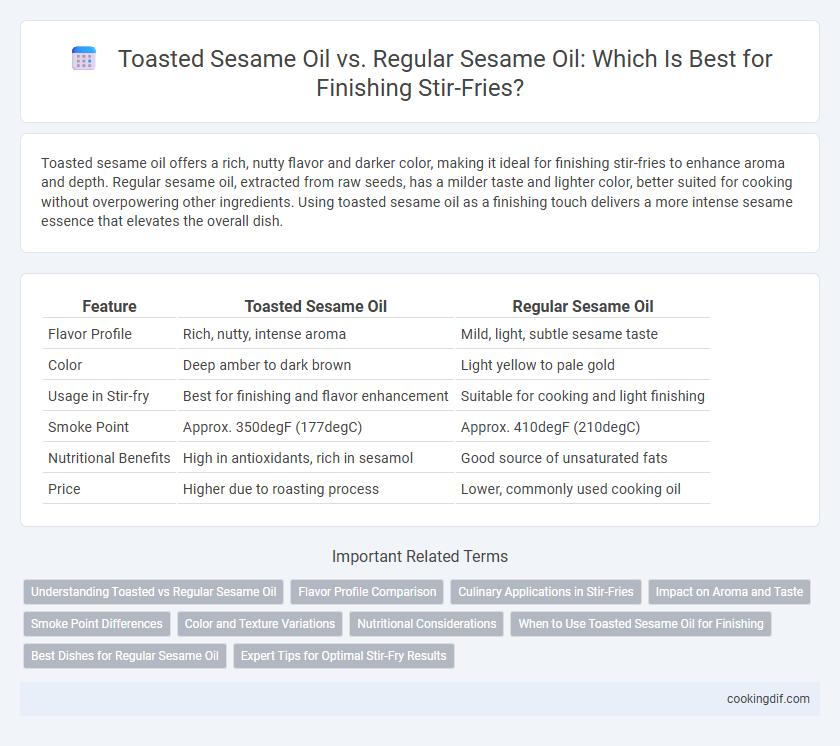Toasted sesame oil offers a rich, nutty flavor and darker color, making it ideal for finishing stir-fries to enhance aroma and depth. Regular sesame oil, extracted from raw seeds, has a milder taste and lighter color, better suited for cooking without overpowering other ingredients. Using toasted sesame oil as a finishing touch delivers a more intense sesame essence that elevates the overall dish.
Table of Comparison
| Feature | Toasted Sesame Oil | Regular Sesame Oil |
|---|---|---|
| Flavor Profile | Rich, nutty, intense aroma | Mild, light, subtle sesame taste |
| Color | Deep amber to dark brown | Light yellow to pale gold |
| Usage in Stir-fry | Best for finishing and flavor enhancement | Suitable for cooking and light finishing |
| Smoke Point | Approx. 350degF (177degC) | Approx. 410degF (210degC) |
| Nutritional Benefits | High in antioxidants, rich in sesamol | Good source of unsaturated fats |
| Price | Higher due to roasting process | Lower, commonly used cooking oil |
Understanding Toasted vs Regular Sesame Oil
Toasted sesame oil offers a richer, nuttier flavor profile compared to regular sesame oil, which is lighter and more neutral, making toasted oil ideal for finishing dishes to enhance aroma and taste. Regular sesame oil, extracted from raw sesame seeds, is better suited for cooking at higher temperatures due to its mild flavor and higher smoke point. Choosing toasted sesame oil for stir-fry finishing adds depth and complexity without overpowering the dish, while regular sesame oil provides subtle sesame notes during sauteing or frying.
Flavor Profile Comparison
Toasted sesame oil offers a rich, nutty flavor with deep, roasted notes that enhance stir-fry dishes when used as a finishing oil, providing a more intense aroma compared to regular sesame oil. Regular sesame oil carries a lighter, more neutral taste with subtle sesame hints, making it suitable for cooking but less impactful as a finishing touch. Choosing toasted sesame oil for finishing elevates the dish's complexity, while regular sesame oil is better suited for the cooking process where its flavor disperses more evenly.
Culinary Applications in Stir-Fries
Toasted sesame oil offers a rich, nutty flavor ideal for finishing stir-fries, enhancing aroma and depth without overwhelming other ingredients. Regular sesame oil, with its lighter and more neutral profile, is better suited for cooking at higher temperatures without imparting strong flavors. Using toasted sesame oil as a finishing drizzle elevates the dish's complexity, while regular sesame oil is preferred for initial stir-frying to prevent burning and preserve balanced taste.
Impact on Aroma and Taste
Toasted sesame oil offers a rich, nutty aroma and deeper, more complex flavor, making it ideal for finishing dishes to enhance taste and fragrance. Regular sesame oil provides a milder, lighter flavor with less aromatic intensity, better suited for cooking at higher temperatures without overpowering other ingredients. Using toasted sesame oil as a finishing touch significantly elevates the sensory experience of stir-fry by adding a distinct, savory depth.
Smoke Point Differences
Toasted sesame oil has a lower smoke point, around 350degF (177degC), making it ideal for finishing dishes to add rich, nutty flavor without overheating. Regular (untoasted) sesame oil boasts a higher smoke point, approximately 410degF (210degC), suited for stir-frying at higher temperatures without burning. Choosing the right sesame oil based on smoke point ensures optimal flavor retention and prevents undesirable burnt tastes in stir-fry dishes.
Color and Texture Variations
Toasted sesame oil offers a deeper amber color and richer, nutty flavor that enhances the visual appeal and complexity of stir-fry dishes, while regular sesame oil remains pale with a milder taste. The thicker viscosity of toasted sesame oil contributes to a glossy finish and slightly velvety texture, contrasting with the lighter, more fluid consistency of regular sesame oil. Choosing toasted sesame oil for finishing elevates both the color vibrancy and mouthfeel, making the dish visually striking and texturally satisfying.
Nutritional Considerations
Toasted sesame oil contains higher levels of antioxidants like sesamol and sesamin, which provide enhanced health benefits compared to regular sesame oil. Regular sesame oil has a milder flavor and retains more polyunsaturated fats, which are sensitive to heat and better preserved when used for finishing dishes. Choosing toasted sesame oil for finishing stir-fries helps maximize antioxidant intake without degrading delicate nutrients found in regular sesame oil.
When to Use Toasted Sesame Oil for Finishing
Toasted sesame oil is best used for finishing dishes due to its rich, nutty flavor and aromatic profile that enhances the overall taste without overpowering ingredients. Regular sesame oil, which has a lighter and more neutral flavor, is better suited for cooking at high temperatures. For stir-fry dishes, drizzle toasted sesame oil at the end to preserve its delicate aroma and provide a flavorful finishing touch.
Best Dishes for Regular Sesame Oil
Regular sesame oil, with its robust and nutty flavor, is ideal for finishing hearty Asian dishes like stir-fried beef, ramen, and sesame chicken, where a stronger sesame aroma enhances the overall taste. Its higher smoke point compared to toasted sesame oil allows it to be used effectively in both cooking and as a finishing drizzle without burning. Regular sesame oil complements spicy and savory profiles, making it a versatile choice for bold-flavored dishes requiring a rich sesame essence.
Expert Tips for Optimal Stir-Fry Results
Toasted sesame oil offers a rich, nutty flavor ideal for finishing stir-fry dishes, enhancing aroma and depth without overpowering the ingredients. Regular sesame oil, with its milder taste and higher smoke point, works better for initial cooking stages but lacks the intensity needed for a perfect finish. Experts recommend drizzling a small amount of toasted sesame oil at the end to preserve its delicate flavor and maximize stir-fry complexity.
Toasted sesame oil vs Regular sesame oil for finishing Infographic

 cookingdif.com
cookingdif.com